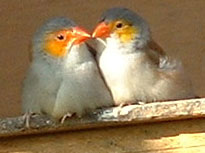Waxbills - Description
 We currently keep three varieties of waxbill, the orange-cheeked,
the red-eared (or common) waxbill and the lavender waxbill. All are African
finches and constitute by far the smallest of our residents. We have three
orange-cheeked, 2 pairs of red-eared and a pair of lavenders. Each of the
3 types of waxbill are always together either feeding, preening or just roosting
as these photographs suggest.
We currently keep three varieties of waxbill, the orange-cheeked,
the red-eared (or common) waxbill and the lavender waxbill. All are African
finches and constitute by far the smallest of our residents. We have three
orange-cheeked, 2 pairs of red-eared and a pair of lavenders. Each of the
3 types of waxbill are always together either feeding, preening or just roosting
as these photographs suggest.
They are hardy and make excellent community birds, fitting in
easily with everything else. I have only seen ours feed on seed which they
take either from the pots or from the ground. They often roost in small bushes
and shrubs rather  than
on the open branches.
than
on the open branches.
We had some sorghum seed itself from the finch mix and I had been curious to know how they feed from the heads of seed. One day I watched a Lavender land on one stalk and bend it over until it met with an adjacent stalk. The bird then balance on the two, being able to stand more or less upright and fed off the base of the head. Something to try and capture on film, one day.
They are not possible to sex and so we have bought 3 or more at a time. In the past, a pair of lavenders nested and laid eggs but they
were disturbed by a kakariki. However, our orange-cheeked have successfully raised a clutch of chicks. They built their nest on the ground under a cottoneaster and the chicks can be seen in the gallery.
There are no gallery images for this bird/plant
Waxbills - facts & figures
Orange-cheeked Waxbill |
| Other names: | |
| Scientific Name: | Estrilda melpoda |
| Length: 2 | 10 cm |
| Incubation Pd: 2 | 12 days |
| Clutch Size: 2 | 4 - 5 eggs |
| Fledging Period: 2 | 21 days |
| Life Span: | |
| Habitat: 5 6 | Wet areas within tall-grass savannas & marshes |
| Diet: | Seed - finch mix |
| Call: | |
 Distribution: 5 Distribution: 5 | Western & West-Central Africa |
| Sound Clip: |  |
| Bred: | We have successfully bred this species |
|
Red-eared Waxbill |
| Other names: | Black-rumped waxbill, Grey Waxbill |
| Scientific Name: | Estrilda troglodytes |
| Length: 2 | 10 cm |
| Incubation Pd: 2 | 12 days |
| Clutch Size: 2 | 4 - 6 eggs |
| Fledging Period: 2 | 21 days |
| Life Span: | |
| Habitat: 5 6 | Wet areas within tall-grass savannas, marshes, tow |
| Diet: | Seed - finch mix |
| Call: | |
 Distribution: 5 Distribution: 5 | A band across central africa from East to West |
| Sound Clip: |  |
| Bred: | We have successfully bred this species |
|
Lavender Waxbill |
| Other names: | Lavender finch |
| Scientific Name: | Estrilda caerulescens |
| Length: 2 | 10 cm |
| Incubation Pd: 2 | 12 days |
| Clutch Size: 2 | 3 - 5 eggs |
| Fledging Period: | 19 days |
| Life Span: | |
| Habitat: 5 6 | Bushy grassland, thronscrub, dry savanna |
| Diet: | Seed - finch mix |
| Call: | |
 Distribution: 5 Distribution: 5 | Western Africa |
| Sound Clip: |  |
| Bred: | We have not bred this species |
|
 We currently keep three varieties of waxbill, the orange-cheeked,
the red-eared (or common) waxbill and the lavender waxbill. All are African
finches and constitute by far the smallest of our residents. We have three
orange-cheeked, 2 pairs of red-eared and a pair of lavenders. Each of the
3 types of waxbill are always together either feeding, preening or just roosting
as these photographs suggest.
We currently keep three varieties of waxbill, the orange-cheeked,
the red-eared (or common) waxbill and the lavender waxbill. All are African
finches and constitute by far the smallest of our residents. We have three
orange-cheeked, 2 pairs of red-eared and a pair of lavenders. Each of the
3 types of waxbill are always together either feeding, preening or just roosting
as these photographs suggest. than
on the open branches.
than
on the open branches. 
